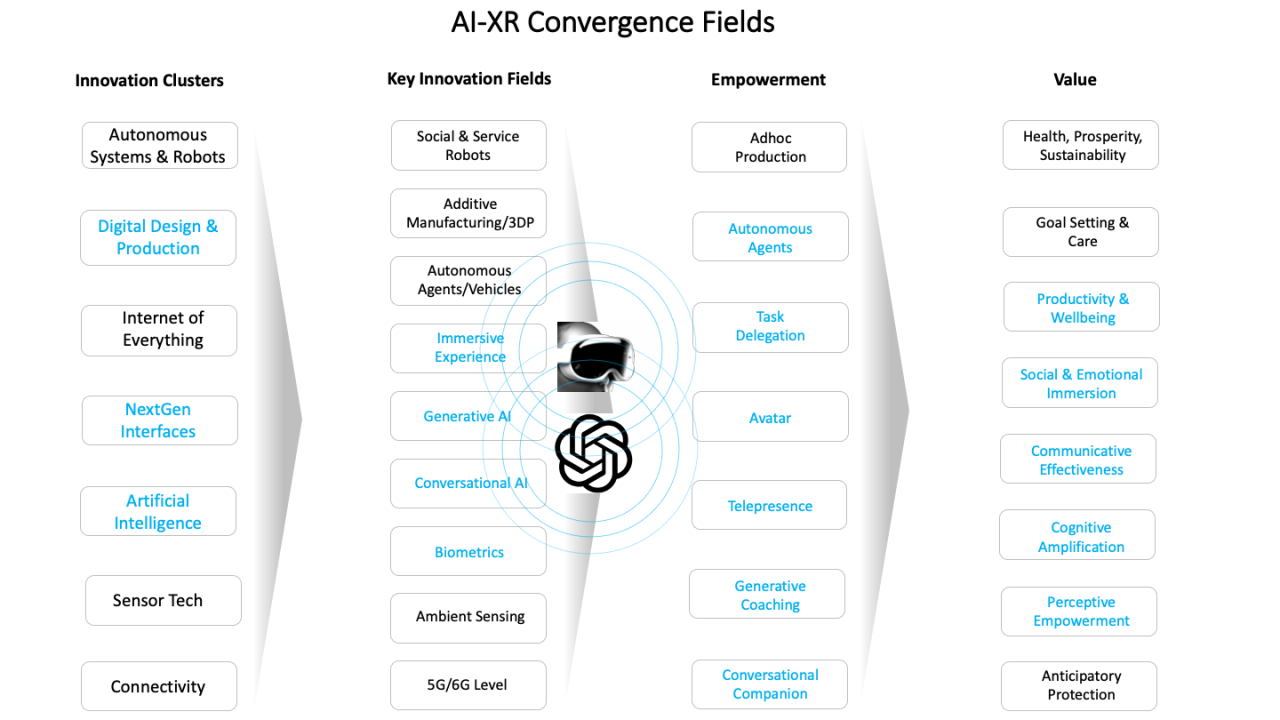AI And XR Convergence: A New Era Of Platform Competition And Opportunity

Table of Contents
Enhanced XR Experiences Through AI
AI is no longer a mere enhancement to XR; it's becoming the backbone of truly immersive and engaging experiences. This transformation is driven by several key advancements:
AI-Powered Content Generation: AI algorithms are dramatically accelerating and enhancing XR content creation. Procedural generation, once a laborious task, now allows for the automatic creation of vast and complex 3D environments, complete with realistic textures and intricate details. This is exemplified by tools like NVIDIA Omniverse and Unity's ML-Agents, which leverage machine learning to generate realistic character animations, dynamic storylines, and interactive objects, significantly reducing development time and costs.
- Examples: NVIDIA Omniverse allows for the creation of photorealistic virtual worlds. Unity's ML-Agents empowers developers to train AI agents within their XR environments, leading to more sophisticated and responsive interactions.
- Advancements: Improvements in AI-driven animation are creating characters with natural movements and expressions. AI is also enhancing physics simulations, creating more realistic interactions within the virtual world.
Personalized and Adaptive XR Experiences: AI personalizes the XR experience, tailoring it to individual users. Adaptive difficulty levels adjust automatically to a user's skill, providing a constantly challenging yet manageable experience. Customized content and real-time feedback further enhance engagement.
- Examples: In gaming, AI adjusts the difficulty based on the player's performance. In education, AI-powered tutoring systems provide personalized learning paths. In training simulations, AI adapts scenarios based on the trainee's progress.
- AI-Powered Avatars and NLP: AI-powered avatars are becoming increasingly sophisticated, exhibiting more human-like behavior and enabling more natural interactions. Natural Language Processing (NLP) is making voice control more intuitive and responsive.
- Data and Privacy: The collection and use of user data are crucial for personalized experiences, but ethical considerations around data privacy and security are paramount.
Improved XR Interaction and Accessibility: AI is revolutionizing how we interact with XR devices. Advanced hand tracking, gesture recognition, and voice control, all powered by AI, create intuitive and seamless interactions. Crucially, AI is also making XR more accessible to users with disabilities.
- Assistive Technologies: AI-powered assistive technologies are being developed to help users with visual, auditory, or motor impairments interact more effectively with XR environments.
- Seamless Interaction: AI translates real-world actions into digital interactions seamlessly, making XR more intuitive and user-friendly for a wider audience.
The Rise of AI-Driven XR Platforms
The convergence of AI and XR is fueling a fierce competition among platform providers. This competition is driving innovation and shaping the future of XR.
Platform Competition and Market Consolidation: Major tech companies like Meta, Microsoft, and Apple are investing heavily in developing AI-powered XR platforms. The race for dominance is intense, with each company striving to offer the most compelling and user-friendly experience.
- Key Players and Strategies: Meta is focused on building the metaverse, while Microsoft is integrating XR into its productivity tools. Apple is expected to enter the market with its own XR device and platform.
- AI's Role: AI is vital for platform development, powering recommendation systems, content moderation tools, and user analytics. These features are essential for creating engaging and safe XR experiences.
- Mergers and Acquisitions: We can expect further consolidation in the XR market as companies seek to acquire promising technologies and talent.
New Business Models and Revenue Streams: AI is unlocking new revenue streams in the XR industry. AI-powered advertising, personalized subscriptions, and microtransactions within XR experiences are transforming the monetization landscape.
- AI-Driven Monetization: AI enables targeted advertising, providing a more relevant experience for users while increasing advertising revenue.
- Challenges: Creating sustainable revenue models remains a key challenge, particularly in a relatively nascent market.
Challenges and Ethical Considerations
While the potential benefits of AI and XR convergence are immense, several challenges and ethical considerations must be addressed.
Data Privacy and Security: AI-powered XR applications collect vast amounts of user data, raising concerns about privacy and security. Robust security measures and transparent data policies are crucial to build trust and protect user information.
- Vulnerabilities and Data Breaches: The interconnected nature of XR systems makes them vulnerable to data breaches, requiring robust security protocols.
- User Consent and Transparency: Obtaining informed consent from users and maintaining transparent data policies are essential.
Bias and Fairness in AI Algorithms: AI algorithms used in XR applications can inherit biases from the data they are trained on. This can lead to unfair or discriminatory outcomes.
- Impact of Biased Data: Biased data can create skewed experiences, excluding or disadvantaging certain user groups.
- Monitoring and Adjustments: Ongoing monitoring and adjustments to AI algorithms are crucial to mitigate bias and ensure fairness.
Job Displacement and Workforce Adaptation: AI-driven automation in XR may lead to job displacement in some areas. Proactive measures are needed to prepare the workforce for the changes and create new opportunities.
- Job Losses and Creation: While some jobs may be lost due to automation, new jobs will be created in areas such as AI development, XR design, and data science.
- Education and Training: Investing in education and training programs is vital to equip the workforce with the skills needed to thrive in the changing landscape.
Conclusion
The convergence of AI and XR is transforming the way we interact with the digital world, creating a new era of platform competition and unprecedented opportunities. AI is fundamental to enhancing XR experiences, driving platform innovation, and unlocking new revenue streams. However, addressing ethical concerns around data privacy, algorithmic bias, and workforce adaptation is crucial for responsible development and deployment. To capitalize on this exciting convergence, explore the possibilities of AI and XR convergence further. Research specific AI-powered XR tools, invest in relevant technologies, and attend industry events focused on AI and XR convergence. Staying informed about this rapidly evolving field is key to success in this transformative era.

Featured Posts
-
 Braunschweiger Karneval Schoduvel 2025 Live Im Tv Und Stream
May 13, 2025
Braunschweiger Karneval Schoduvel 2025 Live Im Tv Und Stream
May 13, 2025 -
 Will Renewed Trump Tariffs Cripple Europes Trade
May 13, 2025
Will Renewed Trump Tariffs Cripple Europes Trade
May 13, 2025 -
 Ostapenkos Upset Victory Stuttgart Open Triumph Over Sabalenka
May 13, 2025
Ostapenkos Upset Victory Stuttgart Open Triumph Over Sabalenka
May 13, 2025 -
 The Gaza Hostage Crisis A Lingering Nightmare For Families
May 13, 2025
The Gaza Hostage Crisis A Lingering Nightmare For Families
May 13, 2025 -
 The Story Behind Partynextdoors Apology To Tory Lanez
May 13, 2025
The Story Behind Partynextdoors Apology To Tory Lanez
May 13, 2025
